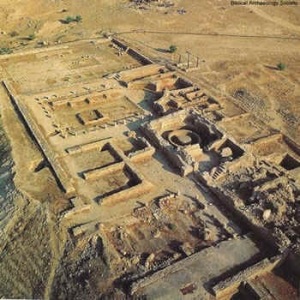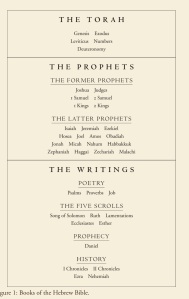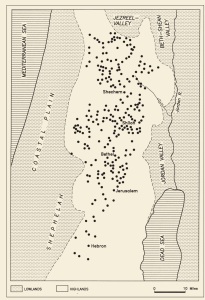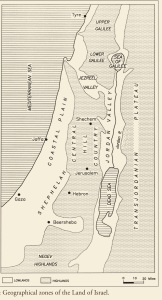 I sometimes get into debates with theists who refreshingly appear to wish to discuss evidence.
I sometimes get into debates with theists who refreshingly appear to wish to discuss evidence.
Not surprisingly, the evidence they have is usually “I’ve got this book”, or “historians admit the Bible is real, they know Jesus existed”.
On investigating further, they will then say there is archaeological evidence to say that all places in the Bible have been proven to exist so the stories in the Bible actually happened, it must all be true. Yes, I know your seeing the flaw in this logic too but, hey, let’s go along with it for a little while. Let’s take a look shall we?
Are you sitting comfortably? Grab me a beer and we shall begin!
ONCE UPON A TIME…
The historical saga contained in the Bible is not a miraculous revelation, but a brilliant product of human imagination. It was conceived, as archaeological evidence suggests, during a span of 2-3 generations about 2,600 years ago.
It is an epic saga woven together from historical writings, memories, legends, folklore, anecdotes, royal propaganda and ancient poetry. Partly original writing and partly adapted from earlier mythological and foreign folk tales.
The 7th Century leaders in Jerusalem declared all traces of foreign worship illegal and embarked on a campaign of destruction to eradicate all traces of alternative mythologies (Sounds familiar right? all religions seem to work the same way, eradicate previous religions so ours looks to be the original – the perpetual irony). From then on Jerusalem’s Temple was recognised as the only place of worship for the people of Israel and modern monotheism was forcibly born.
Such is the power of the Bible story, it has persuaded the world that Jerusalem was always the centre of religion, when infact, it was just another aristocratic family fighting to remain in power despite internal and external threats as many ancient lands went through.
Such a tiny area that the world seems to believe was created by god, and a mere 1,500 acres. Bizarre.
Recent discoveries in archaeology have revolutionised the study of Israel and has cast doubt on the historical basis of such famous biblical stories as The Exodus from Egypt, Conquest of Canaan and the Empire of David and Solomon. What Archaeology aims to do is seperate history from legend, and let me tell you, its as messy as a Tramp’s beard!
THE BIBLE
 The Torah – Five books of Moses – Genesis, Exodus, Leviticus, Numbers and Deutoronomy
The Torah – Five books of Moses – Genesis, Exodus, Leviticus, Numbers and Deutoronomy- Prophets – Joshua, Judges, 1 Samuel, 2 Samuel, 1 Kings, 2 Kings, Isaiah, Jeremiah, Ezekiel, Hosea, Joel, Amos, Obadiah, Jonah, Micah, Nahum, Habbakkuk, Zephaniah, Haggai, Zechariah, Malachi
- POETRY – Psalms, Proverbs, Job
- THE FIVE SCROLLS – Song of Solomon, Ruth, Lamentations, Ecclesiastes, Esther
- PROPHECY – Daniel
- HISTORY – l Chronicles, ll Chronicles, Ezra, Nehemiah
WHO WROTE THE PENTATEUCH
Established religious authorities naturally assume the five books of Moses were written by Moses.
The books of Joshua, Judges and Samuel – by Samuel
Book of Kings – Jeremiah
Psalms – King David
Song of Solomon and Proverbs – King Solomon
By the 17th Century scholars questioned the bible’s reliability
By the 18th Century scholars began to doubt that Moses had any hand in the Bible at all (how right they were!)
PRODUCT OF MANY HANDS
Some scholars argue the texts were composed and edited during the united monarchy in (c 1000-586 BCE).Others insist they were compositions collected and edited by priests and scribes during the Babylonian exile (5-6 BCE) or even as late as Hellenistic (4-2 BCE).
All agree the Bible is not a single seamless composition but a patchwork of different sources, each written under varied historical circumstances to express different religious and political viewpoints.
THE BIBLE WAS WRITTEN WITH AN HISTORICAL BASIS, HOWEVER, CONTRADICTORY BIBLICAL NARRATIVES SUGGEST IT CANNOT BE USED AS A SOURCE FOR PRECISE JEWISH HISTORY.
SOCIAL DEVELOPMENT
We can use the bible as a characteristic artefact that tells a great deal about the society that produced it. We now know that the compiling of such writings are linked to a particular stage of social development, other traits of this stage are monument building, economic specialisation and the presence of a dense network of communities.
The biblical narrative is a product of hopes, fears and ambitions of the kindgdom. The core of the bible arose from clear political, social and spiritual conditions of its peoples. The fanciful stories of Exodus for example, is the creative expression of a religious reform, stories taken from older foreign mythology and used for their purpose.
DEVELOPMENTS IN ARCHAEOLOGY
EARLY ARCHAEOLOGY
 Many of the early biblical archaeologists were trained as clerks or theologians, this of course shaped their results.
Many of the early biblical archaeologists were trained as clerks or theologians, this of course shaped their results.
The French Dominican biblical scholar and archaeologist Roland de Vaux noted :-
If the historical faith of Israel is not founded in history such faith is erroneous, and therefore our faith is also
The American biblical archaeologist William F Albright echoed the sentiment :-
as a whole, the picture in Genesis is historical and there is no reason to doubt the general accuracy of the biographical details
Albright argued that unique details in Genesis might hold the key to verify their historical basis. Sadly later on even Albright realised this couldn’t be so, the search for proof of accuracy was unfruitful. The patriarchal narratives are based on ancient local traditions, his search was unsuccessful since none of the periods around the biblically suggested dates provided any comparable background.
The mistake early biblical archaeologists made was trying to work the excavations to fit the Bible stories. However, new trends began to influence the conduct of biblical archaeology, that changed its focus and completely reversed the traditional relationship between artefact and biblical text.
For the first time archaeologists did not seek to use excavated finds as illustrations of the Bible, in a dramatic shift to the methods of social science, they sought to examine the humans behind the texts.
They started to study the human interaction with the complex fragmented natural environment of the land and how it influenced the development of a social system and their religion. Within the Bible we can see some genuine history if we separate the religious myth and legend.
As the German biblical scholar, Julius Wellhausen said:
“The biblical stories should be regarded as a national mythology with no more historical basis than the Homeric Saga of Odysseus’s travels or Virgil’s Saga of Aeneas’s founding of Rome”
Let us take one or two stories of the bible and take a closer look, I won’t be discussing The Great Flood or The Exodus as I have covered both in previous articles.
DAVID AND SOLOMON
- KING DAVID – 1005-970 BCE
BIBLICAL TESTIMONY – Conquers Jerusalem and makes it his capital; establishes a vast empire covering most territories of the Land of Israel.
ARCHEOLOGICAL FINDS- no evidence of David’s conquests or for his empire. In the valleys Canaanite culture continues uninterrupted. In the highlands continuation of Iron l settlement system.
- KING SOLOMON – 970-931 BCE
BIBLICAL TESTIMONY – Builds the Temple and the palace in Jerusalem. Also active at Megiddo, Hazor and Gezer.
ARCHAEOLOGICAL FINDS – No sign of monumental architecture, or important city in Jerusalem. No sign of grand-scale building activity in Megiddo, Hazor and Gezer; in the north, Canaanite material culture continues.
David became a central figure in the early Israelite history, his slaying of Goliath, his adoption into the royal court as a harpist, his adventures as a rebel, his pursuit of Bathsheba, his conquest of Jerusalem. His son Solomon is remembered as the wisest of kings and the greatest of builders.
For centuries, Bible readers have looked on this era as the golden age in Israel’s history. Until recently many scholars considered these stories as history, they saw it all as an historical saga.
Digging in Jerusalem has failed to produce evidence that it was a great city of David or Solomon’s time. The monuments ascribed to Solomon are now connected with other king’s. If there are no Patriachs, no Exodus, no Conquest of Canaan, no monarchy of David and Solomon how can we say that early biblical Israel as described in the five books of Moses even existed at all?
In the summer of 1993 at Tel Dan in Northern Israel a fragmentary artefact was discovered with the “House of David” inscription, part of a black basalt monument, the evidence dates 100 years after the supposed Davidic Dynasty in the Bible.
Am I saying David and Solomon didn’t exist, not at all, what I am saying is they didn’t exist in the context of the Biblical reference.
Imagine if you will all the written history we have for Europe, the proof of wars, economy, invasion by foreign powers, then invent a sky fairy, voila you have the “European Bible” does the addition of a mythological being mean he is real?
There are indeed some archaeological histories we can attribute to the Bible, but that doesn’t prove a man made god. On the contrary it proves the imagination and socio-economic needs of the ruling classes. No more no less.
Much of what theists take as accurate histories – the stories of Exodus, the monarchy of David and Solomon are actually the creativity of the Judean scholars to control the masses. We are saying they wove a ‘god concept’ into their historical tapestry.
JERICHO
 During archaeological excavations there was no trace of a 13th Century settlement and the earlier bronze age settlement was small and poor, almost insignificant and unfortified. There was also no sign of destruction.
During archaeological excavations there was no trace of a 13th Century settlement and the earlier bronze age settlement was small and poor, almost insignificant and unfortified. There was also no sign of destruction.
Therefore the famous scene of the Israelite forces marching around the walled city with the Ark of the Covenant, causing Jericho’s mighty walls to collapse after blowing their war trumpets, simply didn’t happen, just a romantic mirage.
A similar problem arises between archaeology and the bible when Ai was found, where according to the Bible, Joshua carried out his clever ambush. Scholars identified the large mound of Khirbet et-Tell, as the ancient site of Ai. There was no bronze age site in its vicinity when excavated in 1933 and 1935, a later excavation in the 1960’s produced the same results.
Like Jericho, there was no settlement so no conquest by the children of Israel.
THE FAILED SEARCH FOR THE HISTORICAL ABRAHAM
 So many biblical scholars have been convinced that the patriarchal narratives were historically true. Many of these scholars have been trained as clerics and theologian’s and were persuaded by their ‘faith’ that God’s promise to Abraham was real. Presumably if God’s promise was real it would have been passed onto real people not imaginary creations of some ancient scribes pen?
So many biblical scholars have been convinced that the patriarchal narratives were historically true. Many of these scholars have been trained as clerics and theologian’s and were persuaded by their ‘faith’ that God’s promise to Abraham was real. Presumably if God’s promise was real it would have been passed onto real people not imaginary creations of some ancient scribes pen?
The search for Abraham was unsuccessful, since none of the periods around the biblically suggested dates provide a completely compatible background to the biblical stories. The assigned westward migration of groups from Mesopotamia to Canaan were later shown to be illusory.
Archaeology completely disproved the contention that a sudden mass population move had taken place at that time.
What we can say is the story of Abraham is based on local tribal traditions and may possibly be a legend on a par with King Arthur, the landscape of the patriarchal stories is dreamlike, stitched together from memory, snatches of ancient customs, legends of the birth of the peoples and the concerns aroused by contemporary conflicts. It shows a richness of traditions and the diverse audience it was aimed at.
IN CONCLUSION
The Judean’s became known throughout the Mediterranean as a community with a unique devotion to their God. The Biblical saga gave them a shared vision of solidarity and hope for every individual community as they dispersed over the centuries, a heroic mythology no more or less than Homer’s Illiad or The Odyssey.
***
Would you believe I have now been writing my blog post for a year today, and of the comments I get many are the fact I rarely put links to substantiate my claims. There are three reasons for this.
Firstly- I am I.T. challenged and find adding links somewhat difficult and a pain in the ass, so I rarely include them (ask me and I will send the relevant links to you) .
Secondly – I research on such a scale that adding all links etc would take as many characters as the blogs themselves.
Thirdly – I write the blog for pleasure and as an historian in real life research is second nature to me, this is my downtime which means the blogs are well researched but I add my opinionated self to them ;-).
However on this occasion, I have given you a bibliography list which is half of what I have used for this blog but hope it helps if you wish to delve deeper into what I have discussed. I can of course add a bibliography list to every blog post in future if you are so inclined to further reading…
I can tell you I don’t use google or wikipedia for my research but to give you a tip I definitely recommend Oxford University Press and Academia.edu. among other academic sites and published works.
Please see below listings for this article :-
BIBLIOGRAPHY
- Geography of Israel – Orni, E and Efrat, E
- Who Wrote The Bible – Friedman, R.E
- Archaeology: Theories, Methods and Practice – Renfrew,C and Bahn,P
- The Pentateuch: A Social Science and Commentary – Van Seters,J
- Israels Past in Present Research, Essay on Ancient Israelite Historiography – Philips Long,V
- Ancient Ammon – McDonald, B
- The Late Bronze Age – Biblical Archaeologist 52: 4-39 – Leonard,A
- The Emergence of Early Israel in Historical Perspective – Coote,R B and Whitelam, K W
- The Integrative Transformation: Patterns of Socio-political Organisation in Southern Syria – Marfoe,L
- The Proto-Aeolic Capital and Israelite Ashlar Masonry – Shiloh,Y

Deana, you just get better and better.
Loved this blog, I’m in awe of the research you do and your clear and rational
interpretation of the evidence.
Don’t ever stop.
Love & hugs 👍👍🍷🍷💐💐
LikeLiked by 4 people
I must admit i love getting my teeth into the research for these pieces.
😊😊😘
LikeLike
Happy anniversary sis…. here’s to many more!!
I thoroughly enjoy the blogs and learn so much…… you take me to times and places I never knew existed!! Always a joy to read, if not on occasion a tad scary! Even theists have to admit they’re very educational……. Love ya! E💋💟😇
LikeLiked by 3 people
I enjoy writing them Sis..
Dont stop reading them 😊😊😊
LikeLike
Amazing. I’ve been on a sabbatical, but missed a lot in here. Sure you keep getting better. I love your work. Wonder what keeps the posts here. Others should re-blog them. You’re method is unique, your research is in-depth. Let anyone say I’m biased, but I’d say 10/10. 😉
LikeLiked by 1 person
Thank you M. I love the research even more than the writing, I hope to keep the posts up to your high standards 😊😊
LikeLiked by 1 person
Amazing post!
LikeLiked by 1 person
As usual Deana you educate and entertain with your incredible knowledge of the subject matter. Your writing style flows beautifully and even those with little background in these subjects can find great pleasure in reading your pieces. 😊
LikeLiked by 1 person
I fear I am like a sponge and have som much info in my head that is possibly irrelevent to most, however, if i see a smidgeon of interest via convsrsation on twitter, i rattle away a few musings 😊😊
Thanks for reading and coming up with the title for this piece 😁😁😁
LikeLike
Excellent and in-depth, I always wish similar scrutiny is available on other scriptures and their historic claims. I didn’t pity the Bible when you clipped its imaginary wings of authenticity. Thanks for the article.
LikeLiked by 1 person
Many thanks for reading and your encouraging comments.
For me the research if the fun part, the wriitng is finished in my head before i look at a keyboard.
Let me know if you have any ideas for a piece you would like me to research
Many thanks again
Deana
LikeLike
Ah what a hero you are! This post is excellent. I always verified my rejection of my own faith down to too many similarities in all the different creation stories that exist, and just doing some basic research and reading into what happened in those days substantiates my decision further. I have done an awful lot of research on which to base my decision, and I mean a lot, as giving up one’s comfort zone, way of life, and trying to go against one’s cognitive development is no easy task. I did though, because I would rather not live my life in a lie and be forever doubting. I would rather just know, and have no more questions. This post backs up all that research I was doing instead of my university work, and for that I thank you.
LikeLiked by 1 person
Thank you so much for reading and your comments are much appreciated. I love the research and having studied history since i was thirteen mythology and ancient history is a passion of mine.
If only religion was taught as mythology in schools the world would be a better place. I look forward to following your blog Kris
Many thanks again
Deana 😊😊
LikeLiked by 1 person
Mythology and ancient history are such powerful tools for understanding how dangerous phenomena like Justin Bieber and One Direction become so overwhelmingly and unexplainably popular
LikeLiked by 1 person
Who? 😕😁😁😁
LikeLiked by 1 person
Nice try. I know you have the t-shirts, Demi
LikeLiked by 1 person
Thank you for this brilliant blog Deana.
With the help of the local library, book stores, The Teaching Company, TVO and PBS I too have struggled through Biblical history and found the same facts that you have written about. I find it surprising that people who profess to be Christians DO NOT KNOW ANY OF THIS. What the hell is wrong with people? Why would anyone want to believe mythology when the truth is readily available through modern science? I am completely flummoxed
You and I both know that you are preaching to the choir but you wrote an exceptionally fine blog. I may revisit the era. I wish I could explain things as you do.
LikeLiked by 1 person
Thank you for saying so 😊😊
The subject is a passion of mine and i love getting my teeth into the research for these pieces.
if you do ever wish to have a go at being a guest blogger let me know. Uour choice of subject matter 😊😊
LikeLike
Thank you for your kind offer. For now you have inspired me to revisit the material I have on the OT and NT. I am going to start with the DVDs I got from the Teaching Company .These are lectures presented by Amy Jill Levine and Bart Ehrman..
I read your bit on Akhennaten, I had never learned of the alleged connection with Moses. . Excellent.
LikeLiked by 1 person
Deana this an excellent blog. I know because I have read a great many of the historical and archaeological sources. Documentaries and lectures from assorted biblical scholars have supplemented my learning. All of this information is available to those who WANT to know. It is a sad fact that in this age of almost universal literacy so few people take advantage of the knowledge accumulated by science and properly trained disinterested scholars. This desire to believe what one chooses to believe with little or no evidence is so dangerous. I am speaking particularly of climate change and global warming and the political situation in America.
LikeLiked by 1 person
Thank you Les. I have to say it comes from over 30 years in the field and ongoing study and research.
Religions are merely ideologies and make man blind to realities like climate change…. as you say ignorance to a theist appears to be bliss, to the rest of us it is a cop out and pathetic.
LikeLike
Damn Something is screwed up with my computer. I wanted to add that the greatest ally of religion and politicians is ignorance. And ignorance is alive and flourishing
LikeLiked by 1 person
Isaac Asimov made that very same point 😊
LikeLike
This was well worth resding again.
LikeLiked by 1 person